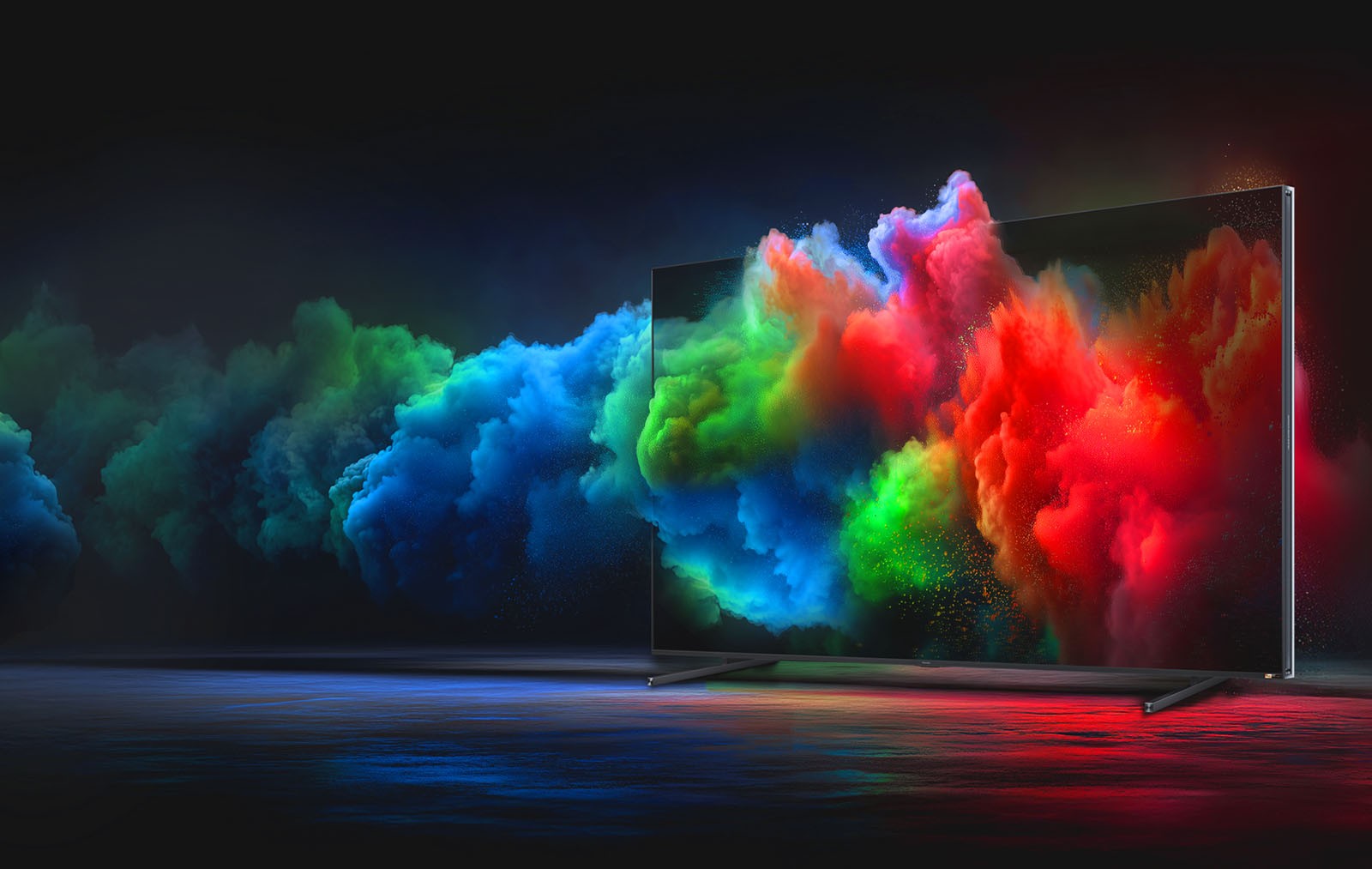Conventional LCD technology has probably, once again, been considered outdated a little too quickly. The backlighting, essential to its operation, has long limited the dynamics of its contrasts and the depth of its blacks. However, the arrival of the Mini LED process, in 2019, has given it a new lease of life. With RGB-Mini LED technology, Hisense goes even further and allows it to stand comparison with the best OLED TVs.
Many thought that the good old LCD panels, omnipresent in televisions on the market, had had their day, eclipsed by [abc]Oled[/abc] as soon as it was a question of products of any quality. However, everything suggests that this is going a little too fast. If, like many manufacturers, aware that the major weakness of LCD panels lay in the lack of depth of blacks, the manufacturer Hisense, with its announcement of RGB-MiniLED technology at the CES show in Las Vegas last January (see our news (UPDATE) CES 25 > Hisense 116UX (295 cm): TriChroma LED TV (Mini LED RGB)), made an impression by demonstrating an impressive qualitative leap. Suddenly, LCD was back in the innovation race... Hisense 116 UXQ RGB-MiniLED, cutting-edge technology already available££££ It should be noted that the brand's research efforts are not new. Numerous experiments have led Hisense to implement a backlighting technology that breaks with conventional methods, based on the use of red, green, and blue Mini LEDs. A choice that the manufacturer Hisense is the first to offer in stores and which makes the brand a true pioneer in the field. What's more, this technology is perfectly suited to the production of very large screens. These specific features allowed Hisense to present a European preview at the IFA in Berlin, the essential Berlin trade show for new audio-video products, last September, a television equipped with RGB-MiniLED technology, but also equipped with the largest diagonal in the world at 116 inches, or nearly 3 meters, or more precisely 295 centimeters.
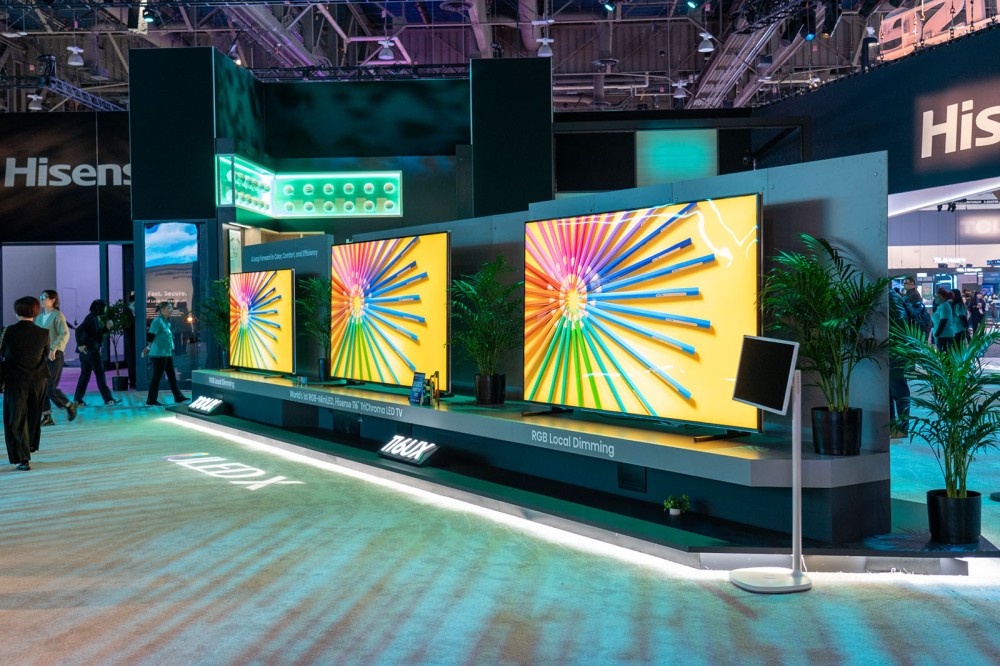
The icing on the cake is that this television is not just a simple prototype or a showcase of Hisense's technological know-how. It is already on the market and will also be present on the brand's stand at the Paris Audio Video Show 2025, taking place in Paris on October 25 and 26 at the Palais des Congrès de Paris, Porte Maillot. Named the 116UXQ, this television is sold in France at a price of 19,900 euros. Hisense 116 UXQ, precise management of fundamental colors…££££ But how does RGB-MiniLED technology represent a real technological breakthrough compared to the conventional Mini LED sector, and what is its qualitative contribution? To answer these questions, we must quickly review the operating principle of conventional Mini LED technology. It is based on a checkerboard of blue [abc]LEDs[/abc]. The light they generate then passes through a Quantum Dot filter which converts this blue light into red or green light in order to recover the fundamental colors essential for the reproduction of a color image, namely [abc]RGB[/abc] (or RGB). Each blue LED constitutes, in fact, a basic cell of the Local Dimming system. However, the panel's management electronics can only globally manage the three basic colors generated since they come from a single blue LED. However, the colorimetric response of the Quantum Dot filter as a function of the lighting intensity is not strictly identical for the three colors. Although very slight, this phenomenon affects the respect of the image's tones.
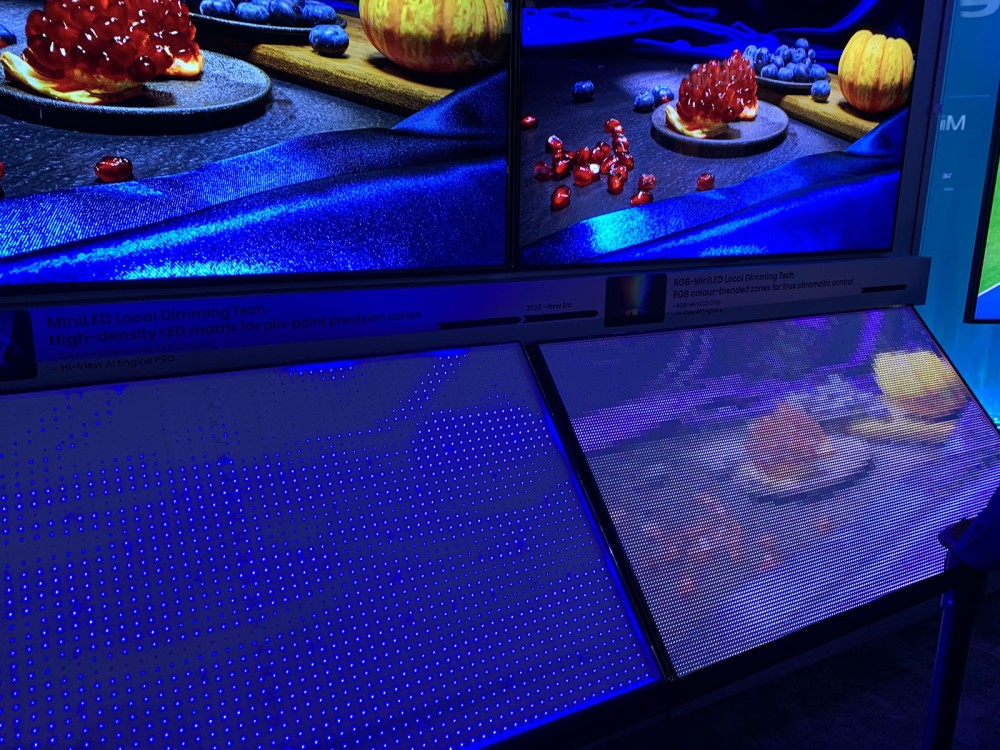
… for natural tones££££ As we have seen, RGB-MiniLED technology is based on a triplet of three LEDs, one red, one green and one blue. The quantum filter is therefore no longer necessary to reproduce these three basic colors. The natural radiation of the three LEDs makes it possible to directly reproduce a color image. The television's video processor can thus very effectively control the brightness and color generated by each diode in an RGB-MiniLED triplet, and with great finesse. The benefits that this technology brings in this area are immediately visible. And the measurements announced by Hisense are also excellent: 95% coverage of the BT.2020 color space, which guarantees that 72% of the spectrum visible to the human eye is reproduced, and 134.78% of DCI-P3. Exceptional results never before seen on a television.
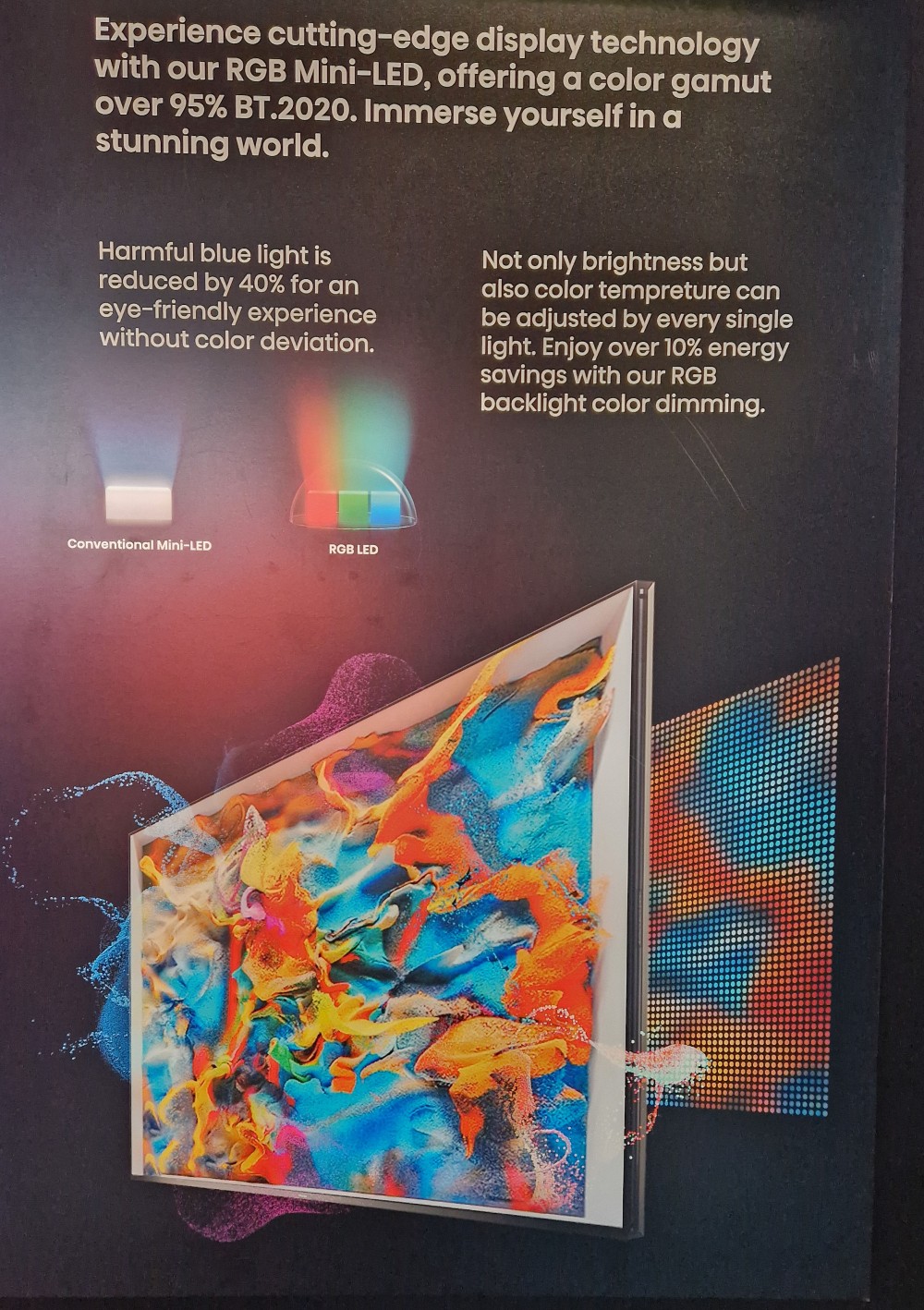
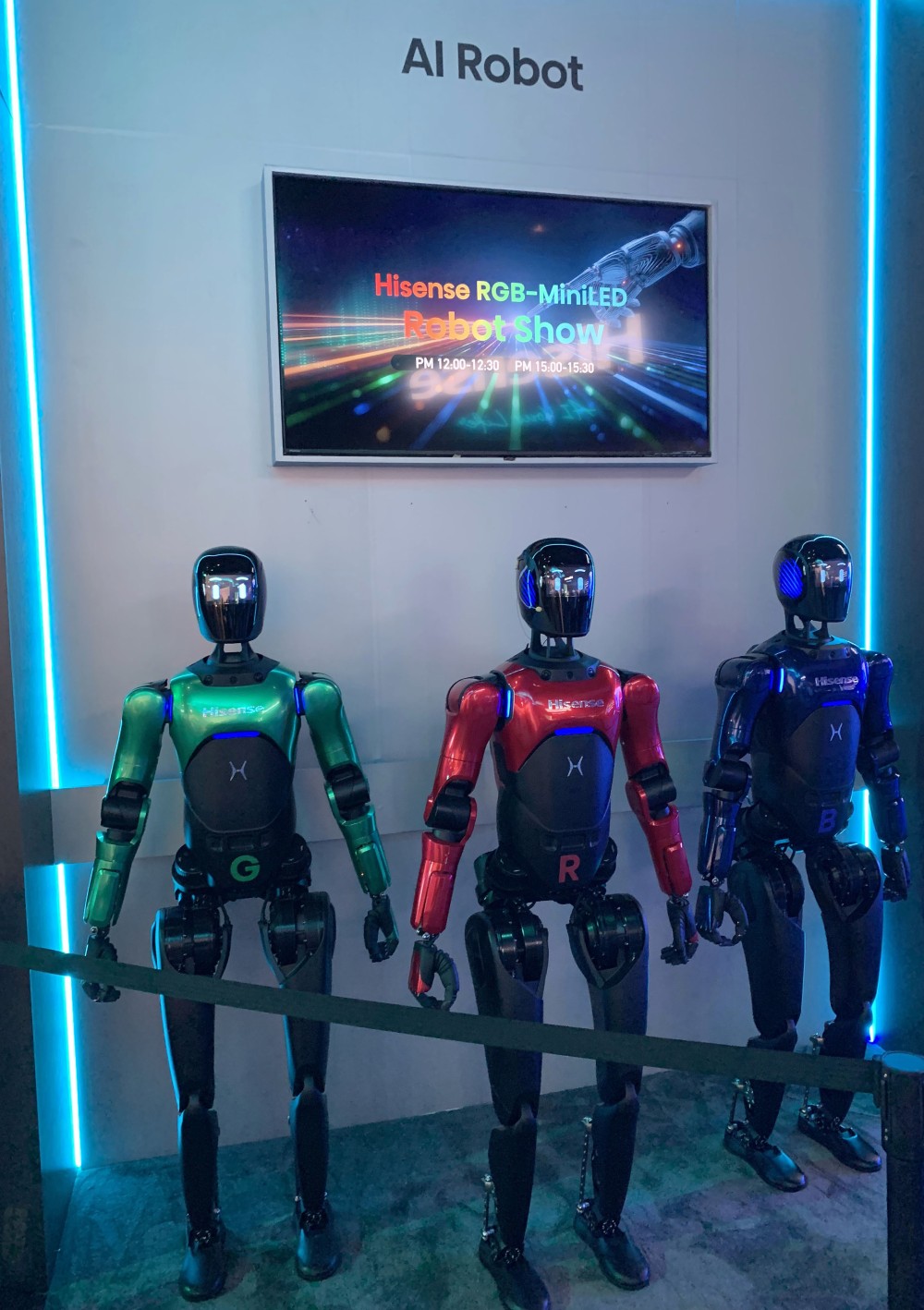
Hisense 116 UXQ, better energy management££££ Concretely, the delivered image presents more intense colors with richer and more subtle hues. Another advantage is that the energy efficiency of a screen equipped with RGB-MiniLED technology is higher than that of a conventional screen. A point that can be explained in a simple way. For example, if the screen must display a purple. It simply turns off the green LED of the RGB triplet and only keeps the red and blue "on". Whereas, on a screen of identical dimensions but with more conventional technology, the three lights, red, green and blue, will be produced, then the blue will be masked. Its emission is therefore a pure waste, which generates unnecessary overconsumption in terms of the overall energy balance of the equipment. Finally, RGB-MiniLED technology limits the emission of blue light to what is strictly necessary. This radiation, harmful to the eyes, is only present when the colors of the image to be displayed use blue. Remember that when using a quantum filter, the blue LEDs are permanently active, which can cause a certain amount of eye fatigue during prolonged viewing sessions.
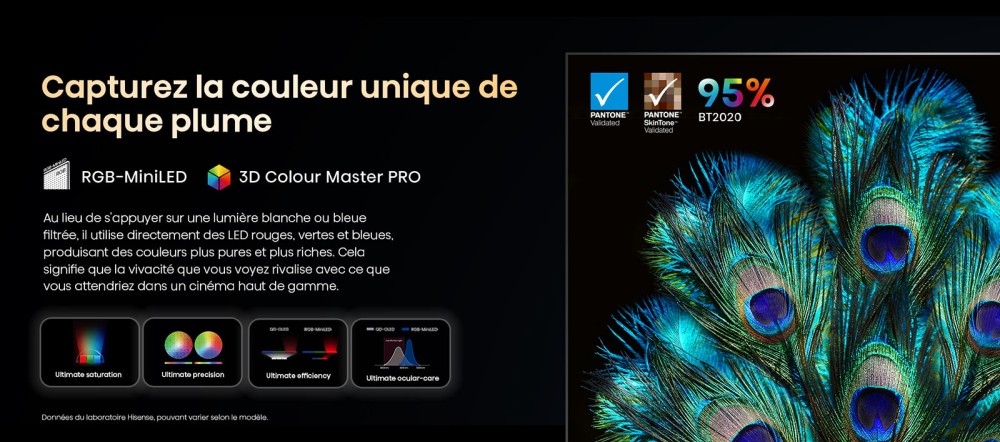
Hisense 116 UXQ, arrival of a Pentonic generation processor 800££££ However, to fully benefit from the advantages of this new technology, Hisense had to design a new video stream processing chip. Called Hi-View Ai Engine X, just like the RGB-MiniLED technology, it boasts unprecedented resources. More precisely, it is a Pentonic 800 generation chip (other players on the market are still only at the 700 vintage). This new version of processors significantly increases image processing capabilities and adaptation to the atmospheres to be rendered. This performance gain reaches 50%, particularly with regard to the use of artificial intelligence. In the gaming domain, for example, the functionalities relating to the recognition of the scene on the screen, contrast, and [abc]Upscaling[/abc] become more efficient. Likewise, for a gain in fluidity, the panel can work up to 165 Hz natively.
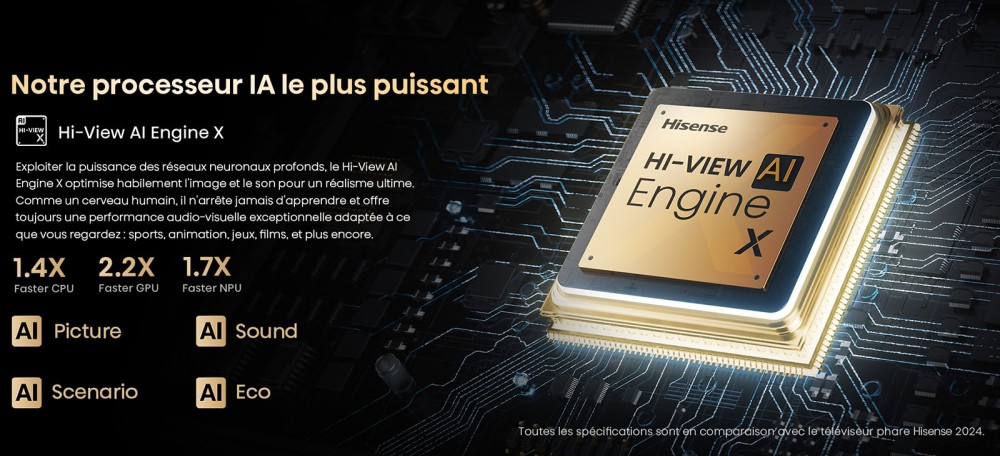
Hisense 116 UXQ, first TV compatible with HDR Dolby Vision 2 ££££ This is probably one of the major elements offered by this new Pentonic 800 chip, it has the resources necessary to meet the HDR Dolby Vision 2 specifications recently presented at the IFA show in Berlin (see our IFA 25 news > HDR Dolby Vision 2, everything you need to know about this new quality standard!). A specificity that makes the Hisense 116UXQ TV the first in the world to be announced as truly compatible with HDR Dolby Vision 2.
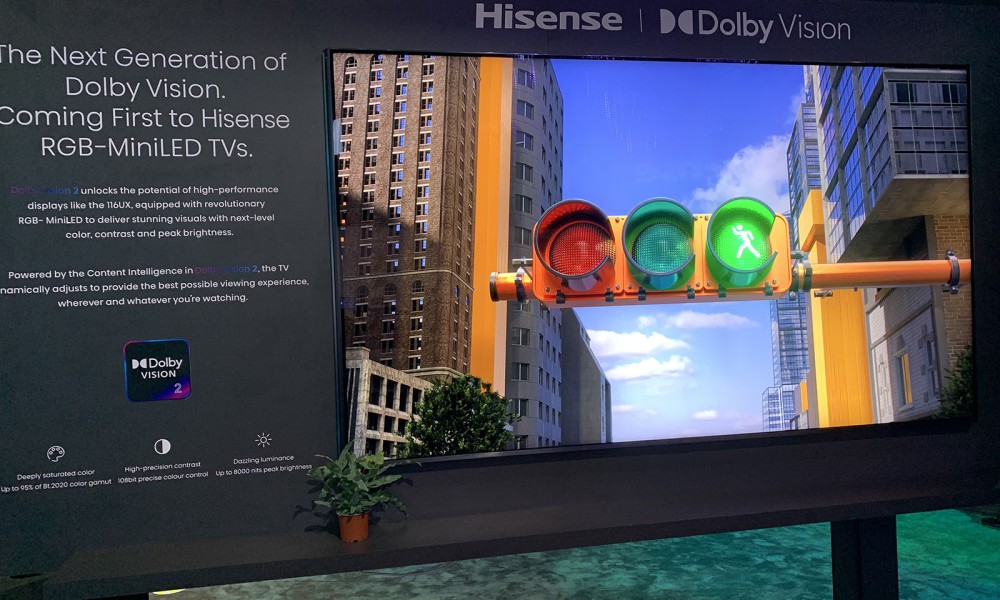
Hisense 116 UXQ, 6.2.2 audio system Opéra de Paris by Devialet££££ The Hisense 116UXQ TV is not content with a spectacular image. Its 6.2.2 sound system, composed of six speakers, two subwoofers and two vertical modules for Dolby Atmos effects, offers an audio spectacle worthy of a concert hall and more specifically the acoustics of the Opéra Garnier, as indicated by the Opéra de Paris by Devialet label. Its objective: to transform each viewing session into a sensory experience, where image and sound merge to create a unique cinematic atmosphere.
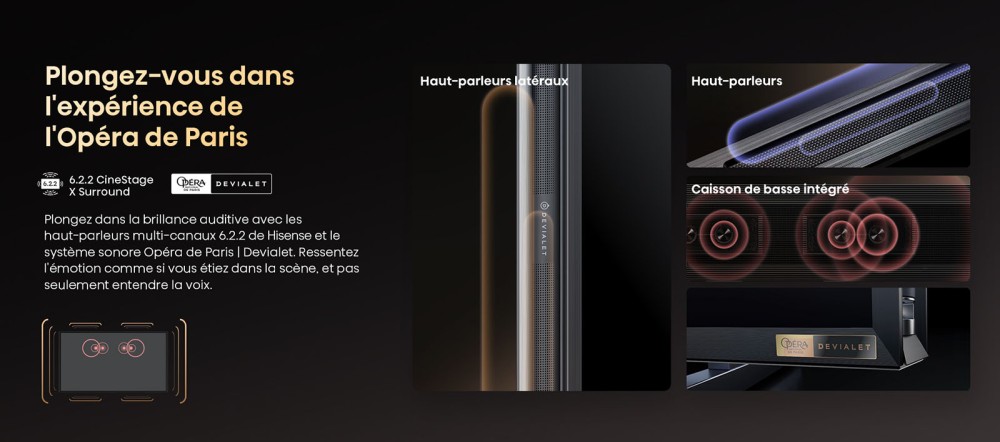
 The icing on the cake is that this television is not just a simple prototype or a showcase of Hisense's technological know-how. It is already on the market and will also be present on the brand's stand at the Paris Audio Video Show 2025, taking place in Paris on October 25 and 26 at the Palais des Congrès de Paris, Porte Maillot. Named the 116UXQ, this television is sold in France at a price of 19,900 euros. Hisense 116 UXQ, precise management of fundamental colors…££££ But how does RGB-MiniLED technology represent a real technological breakthrough compared to the conventional Mini LED sector, and what is its qualitative contribution? To answer these questions, we must quickly review the operating principle of conventional Mini LED technology. It is based on a checkerboard of blue [abc]LEDs[/abc]. The light they generate then passes through a Quantum Dot filter which converts this blue light into red or green light in order to recover the fundamental colors essential for the reproduction of a color image, namely [abc]RGB[/abc] (or RGB). Each blue LED constitutes, in fact, a basic cell of the Local Dimming system. However, the panel's management electronics can only globally manage the three basic colors generated since they come from a single blue LED. However, the colorimetric response of the Quantum Dot filter as a function of the lighting intensity is not strictly identical for the three colors. Although very slight, this phenomenon affects the respect of the image's tones.
The icing on the cake is that this television is not just a simple prototype or a showcase of Hisense's technological know-how. It is already on the market and will also be present on the brand's stand at the Paris Audio Video Show 2025, taking place in Paris on October 25 and 26 at the Palais des Congrès de Paris, Porte Maillot. Named the 116UXQ, this television is sold in France at a price of 19,900 euros. Hisense 116 UXQ, precise management of fundamental colors…££££ But how does RGB-MiniLED technology represent a real technological breakthrough compared to the conventional Mini LED sector, and what is its qualitative contribution? To answer these questions, we must quickly review the operating principle of conventional Mini LED technology. It is based on a checkerboard of blue [abc]LEDs[/abc]. The light they generate then passes through a Quantum Dot filter which converts this blue light into red or green light in order to recover the fundamental colors essential for the reproduction of a color image, namely [abc]RGB[/abc] (or RGB). Each blue LED constitutes, in fact, a basic cell of the Local Dimming system. However, the panel's management electronics can only globally manage the three basic colors generated since they come from a single blue LED. However, the colorimetric response of the Quantum Dot filter as a function of the lighting intensity is not strictly identical for the three colors. Although very slight, this phenomenon affects the respect of the image's tones.  … for natural tones££££ As we have seen, RGB-MiniLED technology is based on a triplet of three LEDs, one red, one green and one blue. The quantum filter is therefore no longer necessary to reproduce these three basic colors. The natural radiation of the three LEDs makes it possible to directly reproduce a color image. The television's video processor can thus very effectively control the brightness and color generated by each diode in an RGB-MiniLED triplet, and with great finesse. The benefits that this technology brings in this area are immediately visible. And the measurements announced by Hisense are also excellent: 95% coverage of the BT.2020 color space, which guarantees that 72% of the spectrum visible to the human eye is reproduced, and 134.78% of DCI-P3. Exceptional results never before seen on a television.
… for natural tones££££ As we have seen, RGB-MiniLED technology is based on a triplet of three LEDs, one red, one green and one blue. The quantum filter is therefore no longer necessary to reproduce these three basic colors. The natural radiation of the three LEDs makes it possible to directly reproduce a color image. The television's video processor can thus very effectively control the brightness and color generated by each diode in an RGB-MiniLED triplet, and with great finesse. The benefits that this technology brings in this area are immediately visible. And the measurements announced by Hisense are also excellent: 95% coverage of the BT.2020 color space, which guarantees that 72% of the spectrum visible to the human eye is reproduced, and 134.78% of DCI-P3. Exceptional results never before seen on a television. 
 Hisense 116 UXQ, better energy management££££ Concretely, the delivered image presents more intense colors with richer and more subtle hues. Another advantage is that the energy efficiency of a screen equipped with RGB-MiniLED technology is higher than that of a conventional screen. A point that can be explained in a simple way. For example, if the screen must display a purple. It simply turns off the green LED of the RGB triplet and only keeps the red and blue "on". Whereas, on a screen of identical dimensions but with more conventional technology, the three lights, red, green and blue, will be produced, then the blue will be masked. Its emission is therefore a pure waste, which generates unnecessary overconsumption in terms of the overall energy balance of the equipment. Finally, RGB-MiniLED technology limits the emission of blue light to what is strictly necessary. This radiation, harmful to the eyes, is only present when the colors of the image to be displayed use blue. Remember that when using a quantum filter, the blue LEDs are permanently active, which can cause a certain amount of eye fatigue during prolonged viewing sessions.
Hisense 116 UXQ, better energy management££££ Concretely, the delivered image presents more intense colors with richer and more subtle hues. Another advantage is that the energy efficiency of a screen equipped with RGB-MiniLED technology is higher than that of a conventional screen. A point that can be explained in a simple way. For example, if the screen must display a purple. It simply turns off the green LED of the RGB triplet and only keeps the red and blue "on". Whereas, on a screen of identical dimensions but with more conventional technology, the three lights, red, green and blue, will be produced, then the blue will be masked. Its emission is therefore a pure waste, which generates unnecessary overconsumption in terms of the overall energy balance of the equipment. Finally, RGB-MiniLED technology limits the emission of blue light to what is strictly necessary. This radiation, harmful to the eyes, is only present when the colors of the image to be displayed use blue. Remember that when using a quantum filter, the blue LEDs are permanently active, which can cause a certain amount of eye fatigue during prolonged viewing sessions.  Hisense 116 UXQ, arrival of a Pentonic generation processor 800££££ However, to fully benefit from the advantages of this new technology, Hisense had to design a new video stream processing chip. Called Hi-View Ai Engine X, just like the RGB-MiniLED technology, it boasts unprecedented resources. More precisely, it is a Pentonic 800 generation chip (other players on the market are still only at the 700 vintage). This new version of processors significantly increases image processing capabilities and adaptation to the atmospheres to be rendered. This performance gain reaches 50%, particularly with regard to the use of artificial intelligence. In the gaming domain, for example, the functionalities relating to the recognition of the scene on the screen, contrast, and [abc]Upscaling[/abc] become more efficient. Likewise, for a gain in fluidity, the panel can work up to 165 Hz natively.
Hisense 116 UXQ, arrival of a Pentonic generation processor 800££££ However, to fully benefit from the advantages of this new technology, Hisense had to design a new video stream processing chip. Called Hi-View Ai Engine X, just like the RGB-MiniLED technology, it boasts unprecedented resources. More precisely, it is a Pentonic 800 generation chip (other players on the market are still only at the 700 vintage). This new version of processors significantly increases image processing capabilities and adaptation to the atmospheres to be rendered. This performance gain reaches 50%, particularly with regard to the use of artificial intelligence. In the gaming domain, for example, the functionalities relating to the recognition of the scene on the screen, contrast, and [abc]Upscaling[/abc] become more efficient. Likewise, for a gain in fluidity, the panel can work up to 165 Hz natively.  Hisense 116 UXQ, first TV compatible with HDR Dolby Vision 2 ££££ This is probably one of the major elements offered by this new Pentonic 800 chip, it has the resources necessary to meet the HDR Dolby Vision 2 specifications recently presented at the IFA show in Berlin (see our IFA 25 news > HDR Dolby Vision 2, everything you need to know about this new quality standard!). A specificity that makes the Hisense 116UXQ TV the first in the world to be announced as truly compatible with HDR Dolby Vision 2.
Hisense 116 UXQ, first TV compatible with HDR Dolby Vision 2 ££££ This is probably one of the major elements offered by this new Pentonic 800 chip, it has the resources necessary to meet the HDR Dolby Vision 2 specifications recently presented at the IFA show in Berlin (see our IFA 25 news > HDR Dolby Vision 2, everything you need to know about this new quality standard!). A specificity that makes the Hisense 116UXQ TV the first in the world to be announced as truly compatible with HDR Dolby Vision 2.  Hisense 116 UXQ, 6.2.2 audio system Opéra de Paris by Devialet££££ The Hisense 116UXQ TV is not content with a spectacular image. Its 6.2.2 sound system, composed of six speakers, two subwoofers and two vertical modules for Dolby Atmos effects, offers an audio spectacle worthy of a concert hall and more specifically the acoustics of the Opéra Garnier, as indicated by the Opéra de Paris by Devialet label. Its objective: to transform each viewing session into a sensory experience, where image and sound merge to create a unique cinematic atmosphere.
Hisense 116 UXQ, 6.2.2 audio system Opéra de Paris by Devialet££££ The Hisense 116UXQ TV is not content with a spectacular image. Its 6.2.2 sound system, composed of six speakers, two subwoofers and two vertical modules for Dolby Atmos effects, offers an audio spectacle worthy of a concert hall and more specifically the acoustics of the Opéra Garnier, as indicated by the Opéra de Paris by Devialet label. Its objective: to transform each viewing session into a sensory experience, where image and sound merge to create a unique cinematic atmosphere. 
